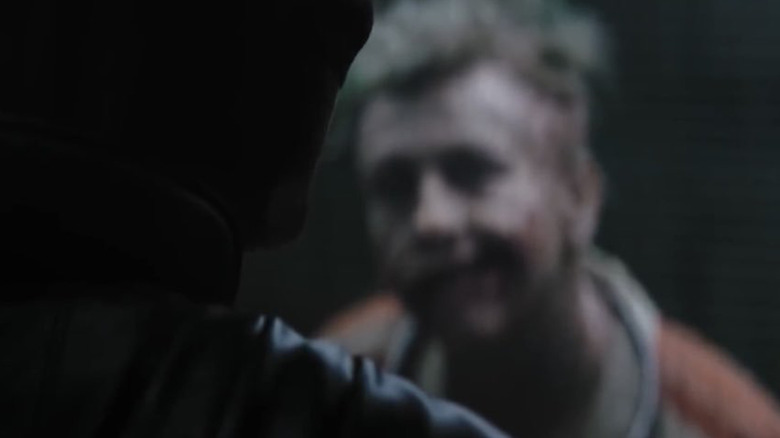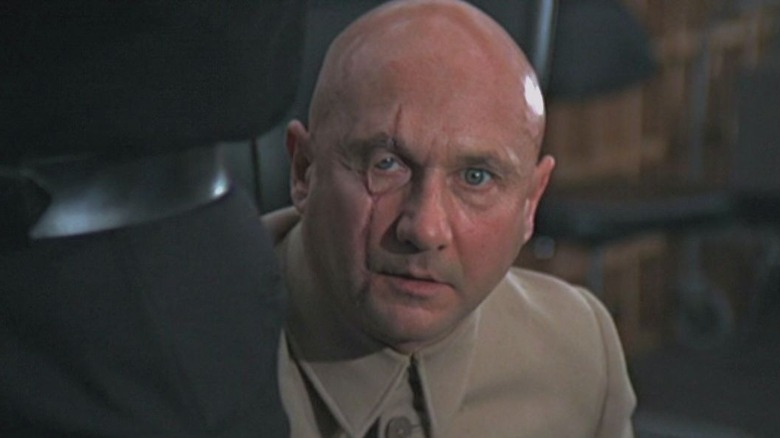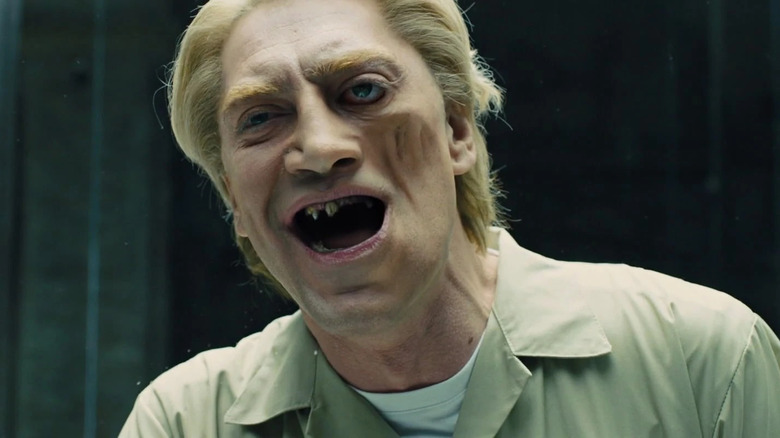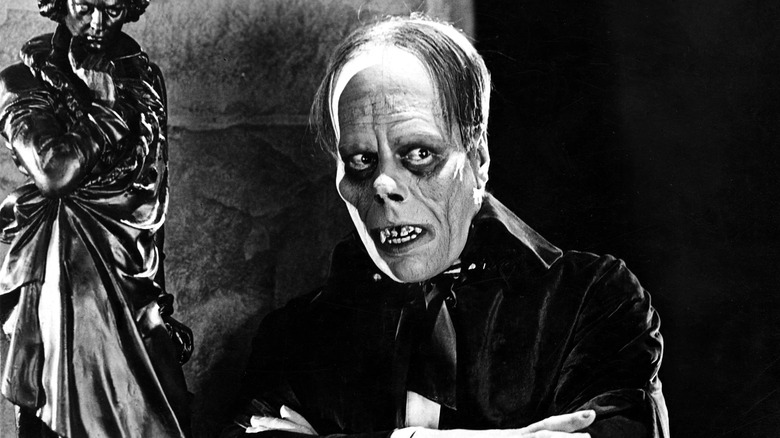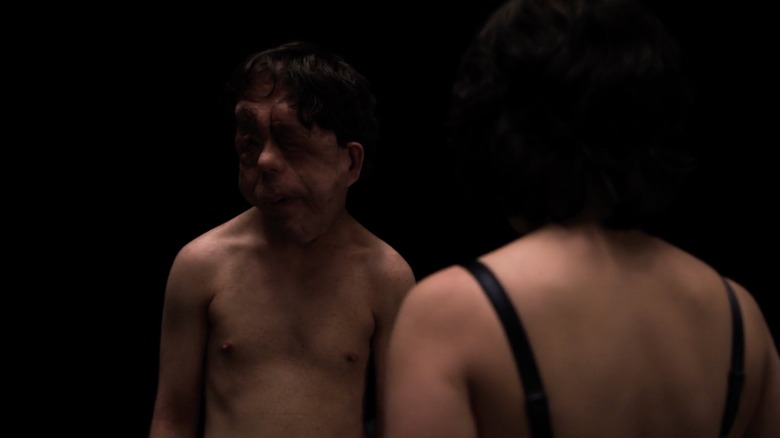The Problem With Disfigured Villains In Pop Culture
Following the multi-million-dollar box office success of "The Batman", Warner Bros. released a deleted scene that showed Robert Pattinson's Dark Knight meeting the Joker, played by Barry Keoghan. This new iteration of Gotham's most infamous villain was only vaguely shown in the film itself and he was never named as the Joker. This was our first glimpse at the latest version of the infamous villain, who we can expect to pop up in any sequels to Matt Reeves' drama. This Joker has a major facial disfigurement that exposes his crooked teeth and has forced his mouth into a grotesque permanent smile. It's a contrast from both Joaquin Phoenix and Jared Leto's Jokers but not a hugely surprising visual choice given that Heath Ledger's version also had facial scars. Jack Nicholson's take was defined by how he was changed into the Joker via a vat of acid and inept plastic surgery. Keoghan's Joker is supposed to repulse us, to strike fear into Batman's hardened heart. We're meant to be scared when we see him. For decades, we've been trained as viewers to see certain people and traits as evil, disgusting, and pitiable — and that's a problem.
It's startling how prevalent this trope is when you stop to think about it for a few minutes: Darth Vader, Scar from "The Lion King," Lord Voldemort, Dr. Poison from Wonder Woman, Freddy Kreuger, Jason, Francis Dolarhyde and Mason Verger from the Hannibal Lecter series, the Grand High Witch, the Phantom of the Opera, and many more. It stands in sharp contrast to the tiny number of heroes who have some sort of facial difference. Indiana Jones has a small scar but who else? If we were to go solely by cinematic history, individuals with scars, disfigurements, or other kinds of facial and physical differences are by default villainous.
Why are scarred and disfigured villains so common?
We are taught to fear anything that looks or seems "different" and we're instinctively afraid of pain and suffering. The combination of the two makes an evil character with scars seem especially potent. Beauty and youth are seen as healthy, desirable, and aspirational. We want the handsome hero to save us, get the girl, and send the baddie on their way (usually to death). Scarring that pretty façade spoils the fantasy and adds something sinister to the illusion. A study from the Perelman School of Medicine at the University of Pennsylvania revealed that the "anomalous-is-bad" stereotype broadened to include attitudes about socioeconomic status as well as morality. Participants in this study openly admitted to having an "explicit bias" and negative feelings towards people with anomalous faces as a group.
We generally still assume that those with facial differences are in some way "wrong," and pop culture reflects that.
A lazy shortcut
Film has never been an industry known for pushing against expectations. It is happy to sit in the cozy nook of the status quo for as long as possible, until remaining there becomes unprofitable or too publicly awkward to do so. We see this in practice whenever Hollywood is asked to offer a crumb of racial or gender diversity. Storytelling shorthand is used as frequently as close-ups and dramatic music stings, so of course we get a lot of bad guys with scars. That's cinema's handy way of letting you know that they're the villain. Maybe we'll get a backstory about how they got those scars (hello, "The Dark Knight") or we'll see them hurt in action, which will spur their turn to the dark side. Sometimes, we'll see a horrifying reveal of their disfigurement, such as Harvey Dent's painful scars and bulging eye in "The Dark Knight" or Raoul Silva removing his dental implant to show a sunken, corpse-like face in "Skyfall."
It's also worth noting that such characters are seldom played by actors who have facial differences. These parts are the domain of certified hotties with asymmetrical faces smothered by prosthetics. We know how such arcs unfold and how unchanging they are, decades after the trope stopped being radical, if it ever was.
No redemption
Some of these characters and their journeys can be compelling, sympathetic even. Go back over 110 years ago to the creation of the "Phantom of the Opera" by Gaston Leroux to see the trope executed with empathy and layers. Erik, the eponymous phantom, was born with deformities so shocking that his mother rejected him from birth. He is described as looking like a corpse from head to toe but is also a talented musician and architect with a golden voice. The novel ends with a moralistic plea to the audience to be more loving towards those who are different. To decry people like Erik as monsters will only make them into the bad guys we so fear, and thus the vicious cycle will continue.
It's a remarkably sophisticated fable for a turn-of-the-century pulp crime novel but one with lessons we could still sorely learn from. The first film adaptation of the Leroux's book cut out the tragic ending and replaced it with a more traditionally villainous death for Erik, because even in its earliest days, Hollywood didn't think there could be redemption of any kind for a scarred man turned monstrous by society's derision of his appearance.
Skin deep
Following the release of the most recent James Bond movie "No Time to Die," the charity Changing Faces, which works to support people in Britain who live with visible differences, started a campaign for the producers to introduce a non-villainous character with facial scarring or disfigurements. The franchise has had more than one scarred antagonist go up against the handsome 007. Catherine Deakin, Changing Faces Deputy CEO, wrote on their website, "When you have a visible difference, you're unlikely to see yourself represented in popular culture [...] It's important we all see more diverse and inclusive images and representations of people, including those who have visible differences, whether that be in a film, our favourite TV shows or in a fashion brand campaign." Three years prior, Changing Faces launched the I Am Not Your Villain campaign to work towards combatting such stereotypes.
As Adam Pearson, a TV presenter and actor perhaps best known for his role in "Under the Skin," noted, "When the only character with a scar or disfigurement is shown on screen as the villain it's perpetuating the use of an old-fashioned and outdated trope. This isn't about banning baddies from having scars or telling people not to enjoy a trip to the cinema, it's about putting a line in the sand and saying now is the time to ensure other characters can be seen on screen with a visible difference too."
Change remains slow but some progress has been made. Following the Changing Faces campaign, the British Film Institute made the decision to refuse funding to projects that used the scarred villain trope. They also directed money towards works that challenged those negative stereotypes and centered characters with facial differences in more positive and three-dimensional ways. The 2019 film "Dirty God," which the BFI helped to finance, stars Vicky Knight as a woman who tries to return to her normal life after experiencing an acid attack. If films are determined to continue having scarred and disfigured villains then the very least they could do is ensure that some of them can be heroes now and then, or even real people just living their lives.
